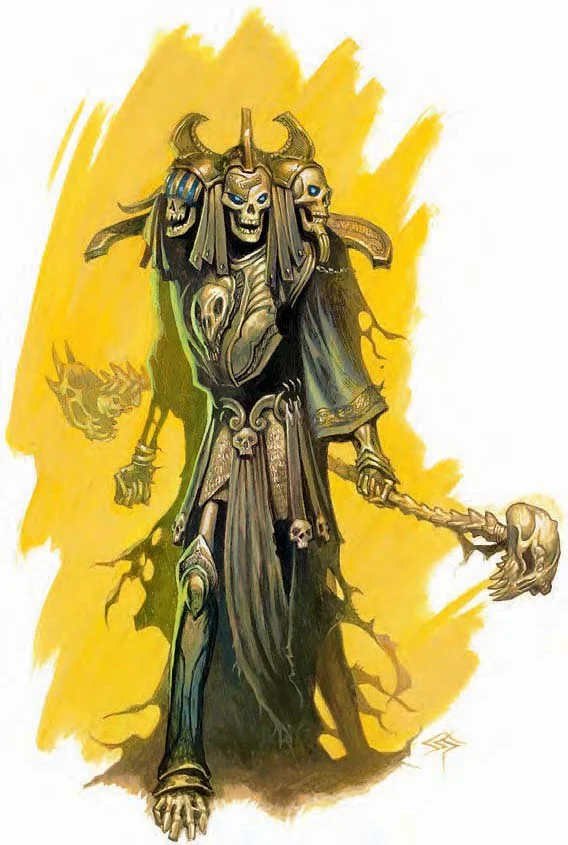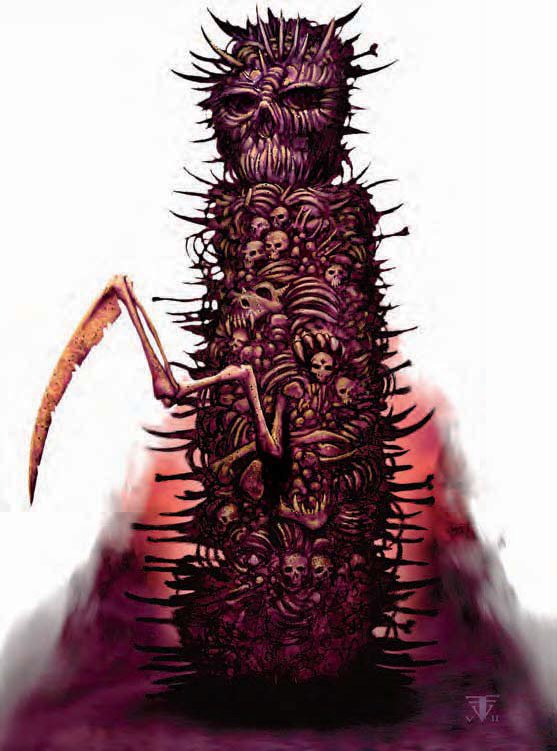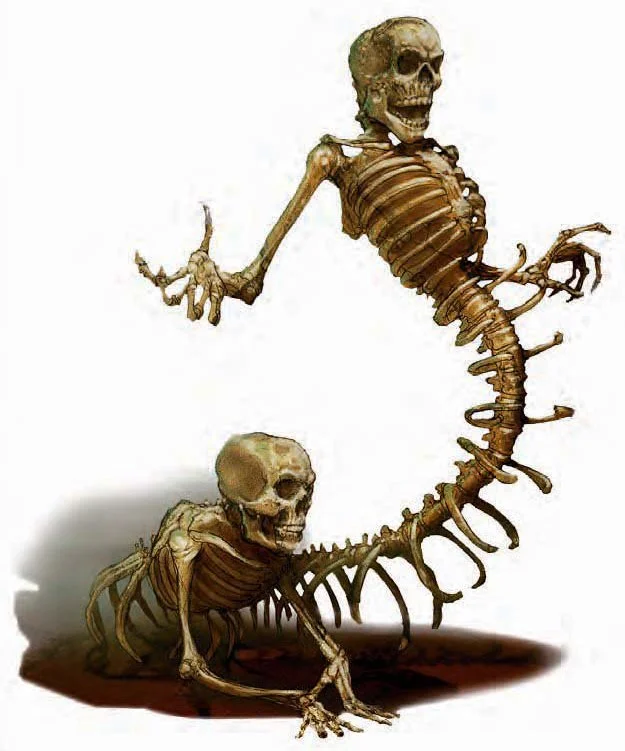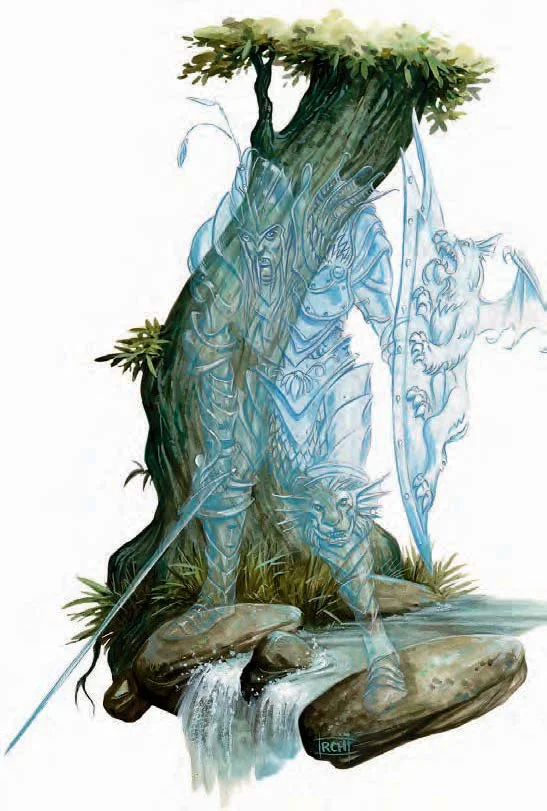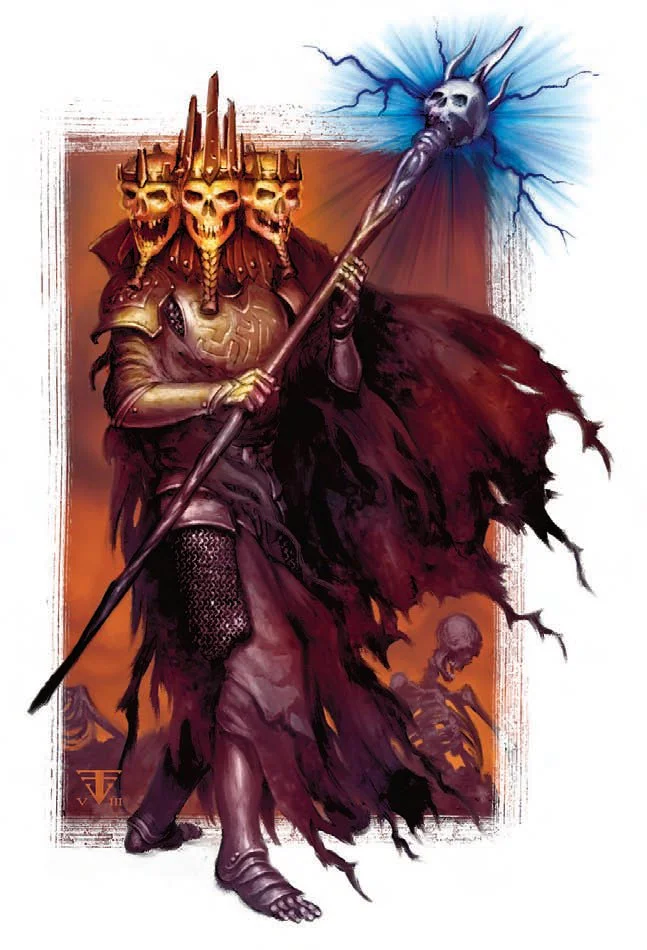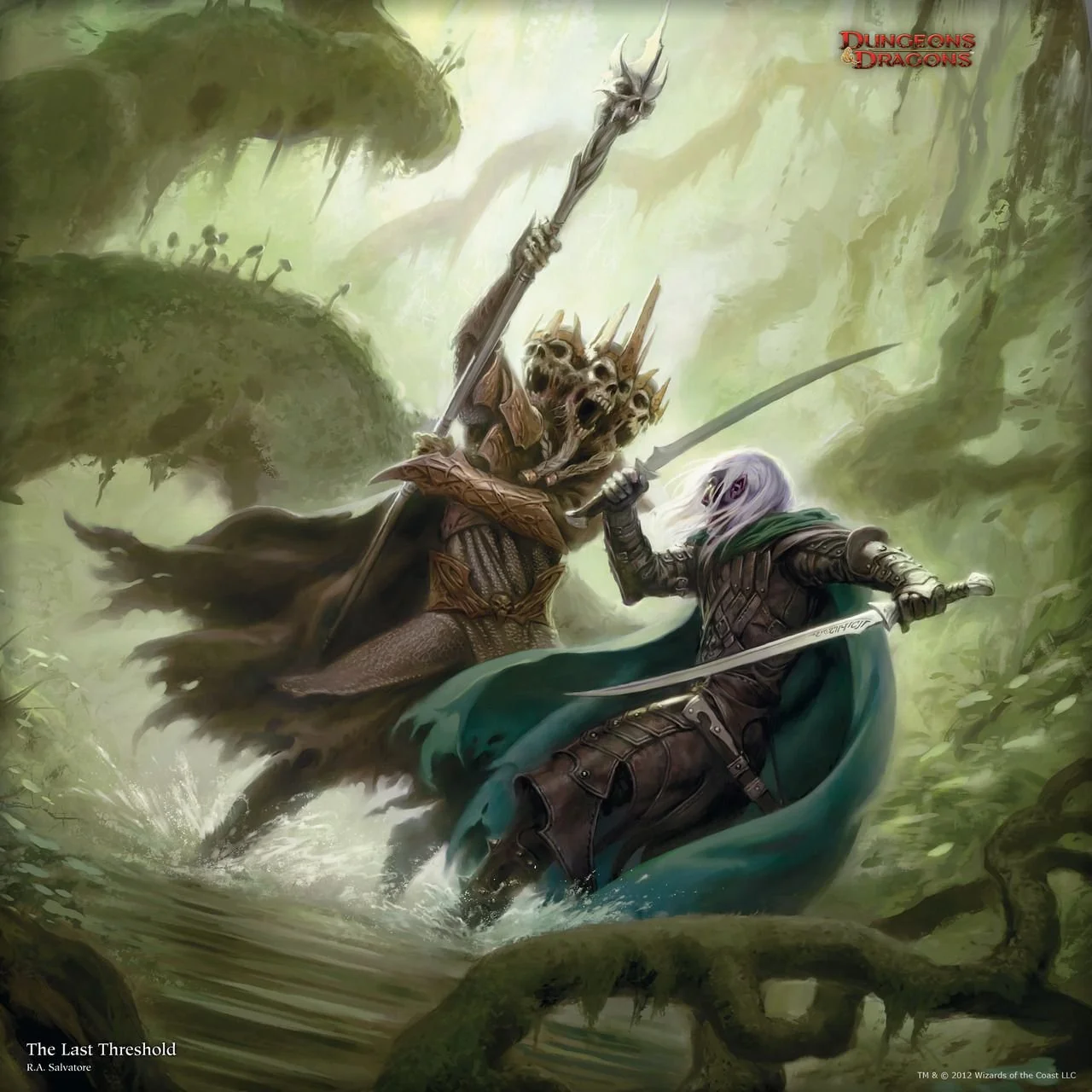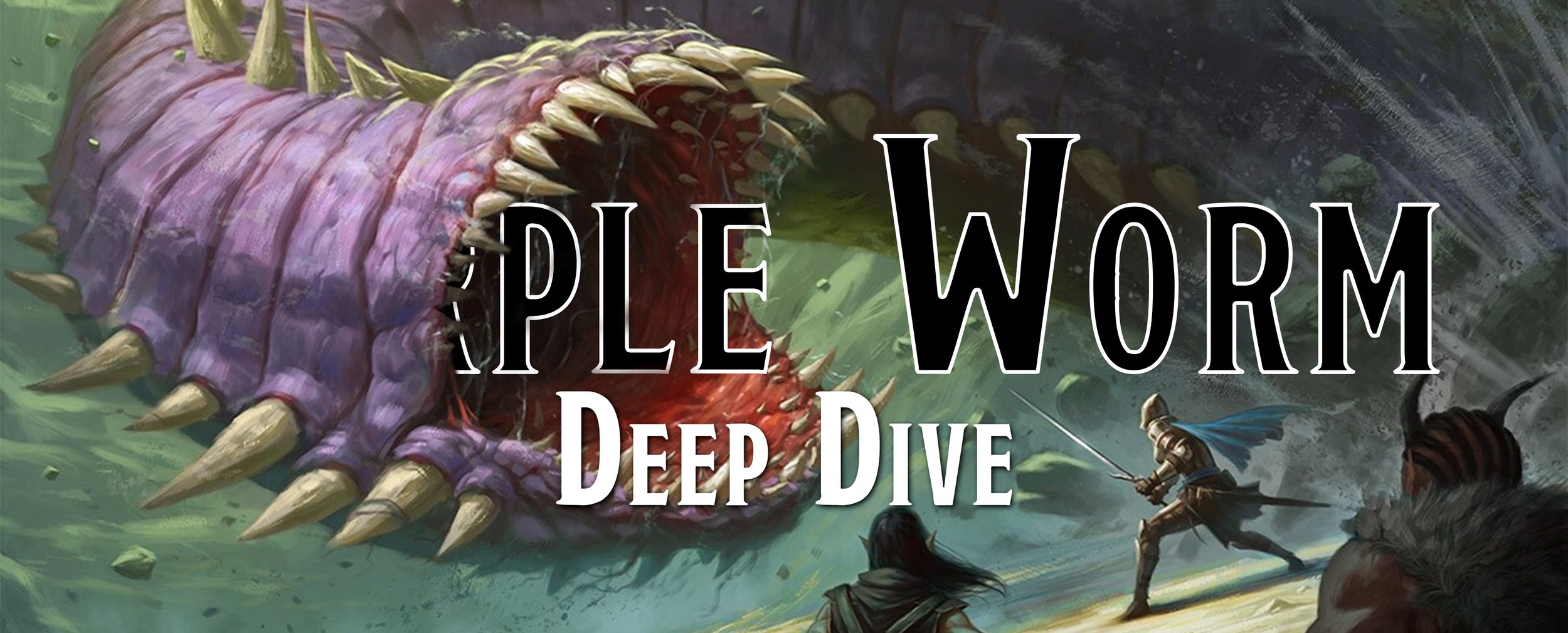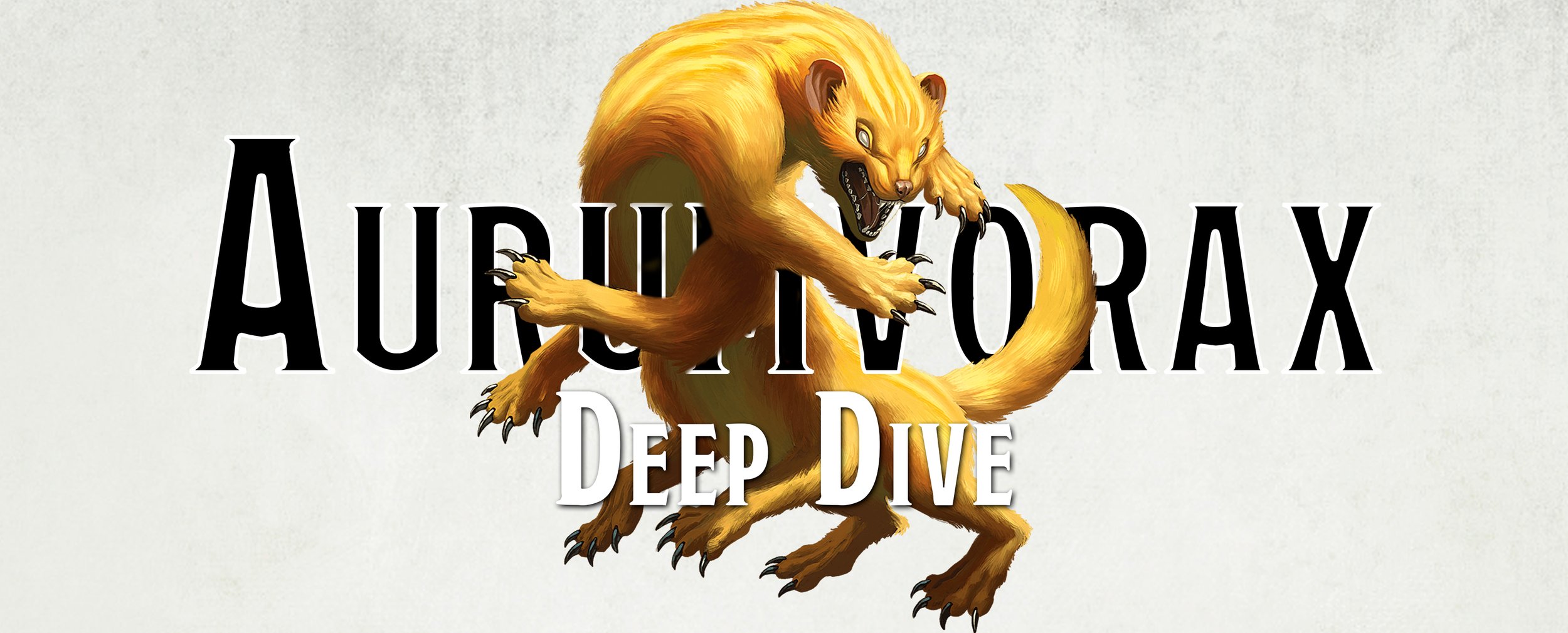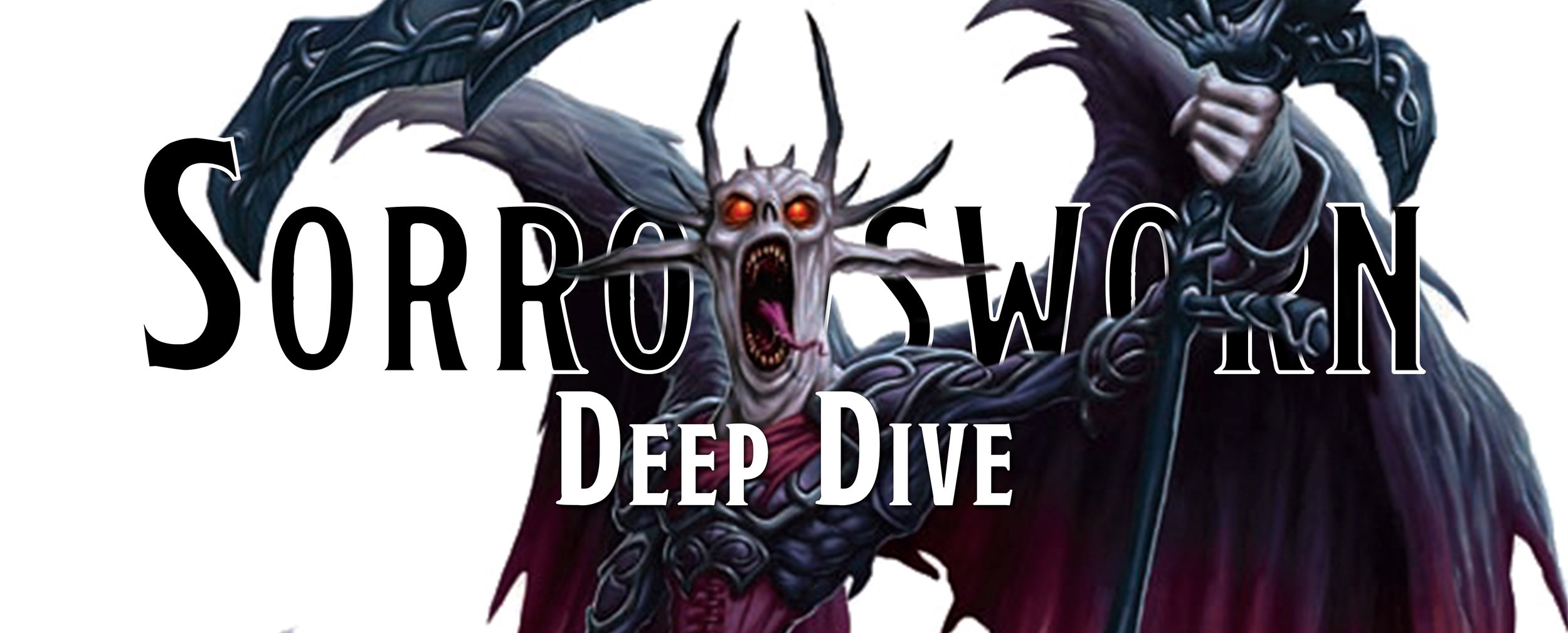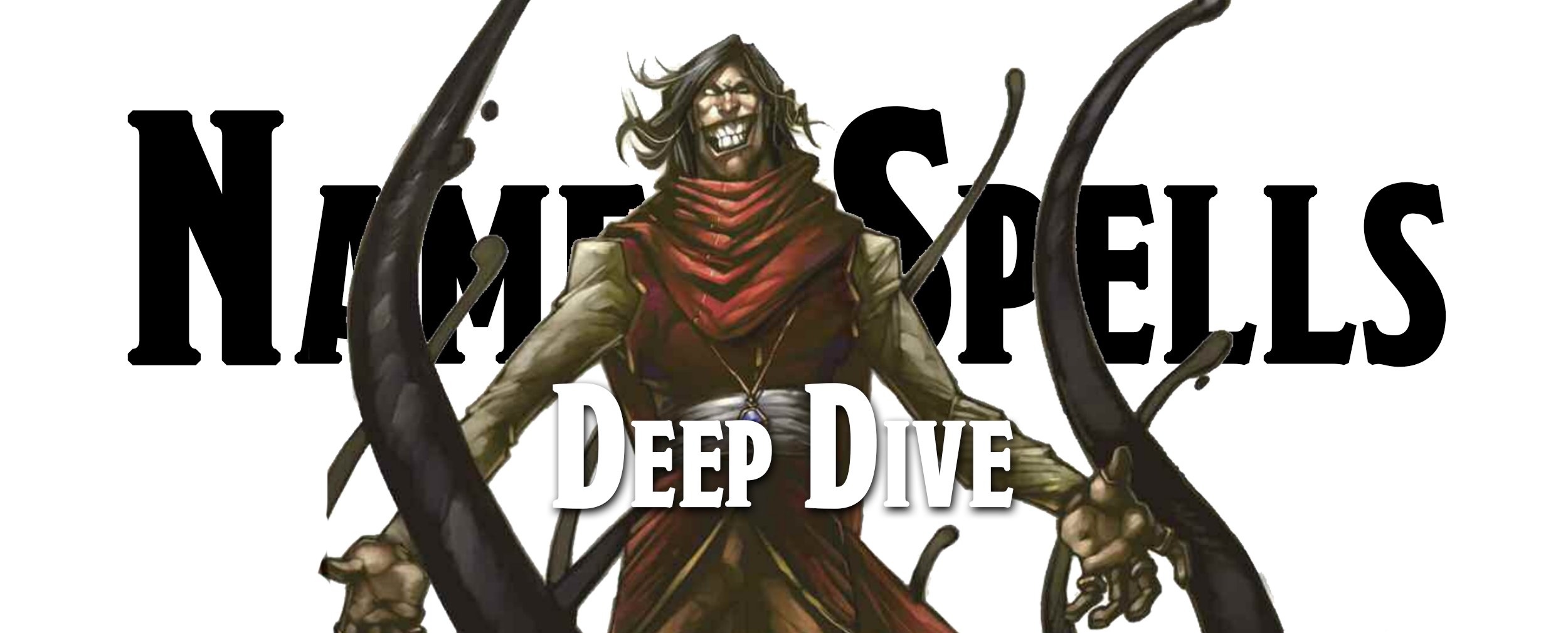Deep Dive - The Skull Lord
With the spookiest month upon us, it is now time to return to our Halloween Deep Dive series. We are starting off by taking a look at the general of undead armies, the Skull Lord. We don’t want to ruin this undead monster before we start, but just remember that three heads are better than one.
3e/3.5e - Skull Lord
Usually LE Medium undead
Init +4; Senses darkvision 60 ft.; Listen +12, Spot +12
Languages Common, Draconic, Infernal
AC 21, touch 14, flat-footed 17 (+4 Dex, +5 armor, +2 natural)
hp 78 (12 HD); DR 5/bludgeoning
Immune cold, undead immunities
Resist +4 turn resistance (see skull loss)
Fort +4, Ref +8, Will +10
Weakness skull loss
Speed 20 ft. (4 squares) in breastplate, base speed 30 ft.
Melee bone staff +12/+7 (1d6 plus 1d6 cold) or Melee bone staff +10/+10/+5 (1d6 plus 1d6 cold)
Ranged bone shard +10 (1d6 plus 1d6 cold; see triple skulls)
Space 5 ft.; Reach 5 ft.
Base Atk +6; Grp +6
Atk Options Point Blank Shot, Precise Shot
Special Actions triple skulls
Combat Gear scroll of inflict serious wounds, scroll of invisibility, scroll of meld into stone, scroll of sculpt sound, scroll of wall of fire, scroll of warp wood
Abilities Str 11, Dex 19, Con —, Int 14, Wis 15, Cha 17
SA triple skulls
SQ create spectral rider, undead traits
Feats Point Blank Shot, Precise Shot, Two-Weapon Fighting, Weapon Finesse, Weapon Focus (bone staff)
Skills Bluff +8, Diplomacy +7, Disguise +3 (+5 acting), Hide +5, Intimidate +10, Knowledge (arcana) +12, Knowledge (dungeoneering) +7, Knowledge (religion) +12, Listen +12, Move Silently +5, Sense Motive +7, Spellcraft +9 (+11 deciphering scrolls), Spot +12, Survival +2 (+4 underground), Use Magic Device +18 (+20 scrolls)
Advancement 13–24 HD (Medium)
Possessions combat gear plus breastplate, royal outfit
Skull Loss When a skull lord is reduced to two-thirds of its full normal hit points, its creator skull shatters. The skull lord loses the ability to create undead, though extant undead remain under its control. When a skull lord is reduced to one-third of its full normal hit points, its spitting skull shatters, and it loses its bone shard ability. If a skull lord is healed so that its hit points once again exceed one-third or two-thirds of its full normal total, the appropriate skull reappears. The skull lord then regains the use of the ability granted by the skull. A skull lord and the undead it controls have +4 turn resistance as long as the skull lord has all three of its skull heads. This turn resistance is reduced to +2 if a skull lord has only two heads, and it is lost when a skull lord has only one head remaining.
Bone Staff (Su) A skull lord’s bone staff functions as a masterwork quarterstaff that deals an extra 1d6 points of cold damage. A bone staff is treated as a natural weapon for the purpose of the skull lord’s use of its Weapon Finesse feat. If a skull lord loses possession of its bone staff, the bone staff is destroyed. A skull lord can create a new bone staff as a swift action. To do so, it must slay one of its created undead servitors within 30 feet. The chosen servitor is instantly destroyed as the bone staff reappears in the skull lord’s hands.
Triple Skulls (Ex) Each round as a swift action, a skull lord can use one of these abilities: bone beckon, bone shard, or create servitor. If a skull lord loses a skull (see skull loss), it loses access to one of the abilities. Bone Beckon (Su) A skull lord can use its beckoning skull to bring forth fragments of bone from the body of an opponent within 30 feet that has a skeletal system. The creature must succeed on a DC 19 Will save or take 2d6 points of damage as the shards are torn from its body. Nonintelligent undead creatures do not get a save. A skull lord can instantaneously cause the shards to be absorbed by a corporeal undead of its choice within 30 feet (including itself). The chosen undead heals 5 points of damage. Alternatively, a skull lord can hold the shards in the mouth of its spitting skull (see the bone shard ability).
The Skull Lord is first found in the Fiendish Codex I - Hordes of the Abyss (2006), or at least, a creature known as a Skull Lord is found there and only briefly mentioned. See, these Skull Lords were once mortals in the service of Orcus and it is more of a title. Once these mortal worshipers reached a high enough level, Orcus would beckon them to the 113th layer of the Abyss, Thanatos, to control his hordes of undead, readying them to invade the Material Plane.
Monster Manual V, 2007 Wizards of the Coast / Steve Prescott
The Skull Lord then appears and gets the full treatment in the Monster Manual V (2007), and now there is no mention of Orcus, but they do field large armies of undead. Perhaps these two Skull Lords are different, perhaps they are the same. Maybe Orcus and this mysterious Vrakmul mentioned in the Monster Manual V thought Skull Lord was an awesome name and decided to use it without first checking if it was trademarked or not. Either way, it totally is an awesome name and we want it carved on our tombstones.
The first thing you’ll notice about Skull Lord is its ridiculously long stat block. And wait until we tell you about the additional minion stat block in the Skull Lord description. Wait, not just one minion, but two minions. But we are getting ahead of ourselves. For now, let’s focus on our three-headed friend, the Skull Lord. There’s a lot to unpack.
Ever heard of the famous necromancer Vrakmul? That’s ok, neither have we. Want to know why? Because outside of being referenced in the description of the Skull Lord, they don’t exist! A small excerpt tells you to feel free to create your background and lore for the necromancer. If that seems like too much work (it is), it suggests you ignore Vrakmul altogether and make up your own edgelord story. Well, not those words exactly, but you get the idea.
Let’s discuss what we do know about Vrakmul, the creator of the Skull Lords. We say Skull Lords because there are only twelve in existence. Vrakmul created them in death when his Black Tower fell. From the ruins of the tower emerged the Skill Lords. Since that time, they have had one purpose in this world. They search for the relics left behind by the now-dead Vrakmul—a mask of the skull, a rod of withering, and a staff of necromancy—which will somehow bring him back to life. We guess there is some lore after all.
A Skull Lord appears as a standard skeleton of a long-dead humanoid… with the small difference being the three skulls instead of the normal one. Each Skull Lord has a unique armor and cloak so that you can tell them apart. How thoughtful of them.
As for what else you might on them, they carry scrolls of all types and wield a Bone Staff. It’s a quarterstaff made of bone, not surprising, and is a unique item to the Skull Lord. It deals normal bludgeoning damage but also inflicts cold damage because we guess being dead is cold. If the Skull Lord has a rough night at the graveyard bars and loses their staff, or you somehow manage to destroy it, the Skull Lord isn’t worried. The undead horror can recreate its staff by destroying one of its skeletal servitors.
Three skulls mean three cool abilities to defeat their foes, which, unfortunately, is you. The three abilities are Bone Beckon, Bone Shard, and Create Servitor. Bone Beckon allows a Skull Lord to rip fragments of bones out of your body. And we literally mean out of your body as it rips out these fragments from you. The Skull Lord can absorb the fragments into their own body, healing them, send them to another nearby undead to heal them, or have one of their skulls suck up the bone shards like a tasty snack.
If the Skull Lord takes your bone fragments as a tasty snack, it can then use its next unique ability, Bone Shard to spit those fragments at another creature. This attack is the equivalent of a wizard’s magic missile spell if they fire off the shards at the creature from which they were so savagely taken. While you might hope that regaining your bone fragments would heal you like a Skull Lord, it actually does the opposite of that as it deals piercing and cold damage to you. You’ll have to tell us what it’s like to have your own bones betray you.
Before we tell you about the Skull Lord’s third skull ability, we should tell you how the Skull Lord likes to fight. We have told you about it cracking you over the head with its bone staff and tearing bone shards from your body, but they’d rather avoid getting up close and personal. Instead, the Skull Lord uses its undead minions and servitors to do the dirty work, using them to engage in melee combat and serve as meat bone shield. This way, the Skull Lord doesn’t get its hands dirty or risk one of its precious skulls in combat.
Back to the third skull’s ability, Create Servitor. By using this ability, the Skull Lord creates a Bonespur, a Serpentirs, or a skeleton from bones that may be lying around. The bones determine the type of skeleton created, which could be anything from a typical skeleton from humanoid bones to a young dragon skeleton. The number and type of undead are equal to an encounter level (EL) 7, which is this edition’s version of Challenge Rating. The example given of what that equates to is four Bonespurs, three Serpentirs, or a cloud giant skeleton. Depending on what the Skull Lord is up against, it could decide whether more creatures give a better chance of winning the fight or one massive skeleton will do the trick.
You know how we mentioned that the Skull Lord doesn’t want to risk one of its skulls? That was foreshadowing. If the Skull Lord is reduced to two-thirds of its total hit points, the creator skull explodes and the Skull Lord loses its Create Servitor ability. If you reduce them down to one-third of their hit points, instead the Spitting Skull is destroyed. You’ll never guess what happens if you reduce them to zero-thirds their hit points (they die and you win).
Before you get too excited, we should tell you that the Skull Lord can regrow its heads. It will reform the appropriate skull when it regains hit points to the abovementioned levels. And you thought something was finally going your way and that you could gain the title of Skull Lord for yourself!
Monster Manual V, 2007 Wizards of the Coast / Franz Vohwinkel
As mentioned, let’s talk about the unique minions a Skull Lord can create with the Bonespur, Serpentir, and Spectral Rider. A Bonespur is a terrifying pile of bones that can change shape. When you first encounter one, it appears to be a 400-pound, 12-foot-high column of bones with a skull composed of multiple bones resting on top. From the center of the column protrudes a long bone scythe. It will waggle the scythe in your direction, just like a mom does at their child when scolding them. Here’s where it gets really disturbing. As you stand there in shock, the bones re-shape themselves into the form of a giant rhinoceros, complete with a huge horn on its head.
You know those nature documentaries showing the animals roaming the plains of Africa? At some point, they always cut to an animal charging at the camera, all angry about being filmed like a movie star, and the cameraman is the paparazzi. That’s what the Bonespur-rhino does, rushing towards you with surprising speed. Upon crashing into you, it explodes into a cloud of bone shards. Those bone shards return to their original form, now close enough to waggle their scythe right into your sternum. You may not have to worry about the scythe. One of the Bonespur’s favorite things to do is push you off a high ledge, the edge of a cliff, or anything that will cause gravity to kill you.
Monster Manual V, 2007 Wizards of the Coast / Arnie Swekel
The Serpentir were also created by the Skull Lord but no longer work exclusively for them. Their need to kill everything and unquenchable hunger for living flesh drove them to free themselves from the Skull Lord's control. They are a sight to be seen, and not in a good way. The Serpentir is made up of skeletal bodies linked to each other by their spines. They have a skull head and two arms with clawed hands at each end. They love to attack from the shadows, jumping out and grabbing their prey. Once trapped in their bony embrace the Serpentir opens its ribcage like a giant mouth, the the individual ribs as its teeth. As it munches on your supple flesh, you are trapped within its churning ribs and the Serpentir can go back into the shadows to finish digesting its meal.
Monster Manual V, 2007 Wizards of the Coast / Ralph Horsley
Finally, once a month, the Skull Lord can create a Spectral Rider. This twelve-hour ritual can only be performed under a dark moon and from the remains of a mounted creature. Their time and effort are rewarded, as the Spectral Riders are powerful undead who become knights in the service of the Skull Lord. They will use the phantom steed spell to ride upon a quasi-real horse. When doing so, the Spectral Riders will appear like the person they were when they were alive.
Once you have defeated the lesser undead creatures, the Spectral Riders spring into action. When they aren’t up on their mount, you’ll see they’re sneaky undead bastards, revealing their true form: undead knights with skull-like faces inside their helm. The Spectral Knight has a multitude of attacks and abilities. Defiling Touch adds additional damage when it pokes you with its bony finger. Unholy Strike also adds damage, but they can wield a weapon now. We’re not going to bother explaining their Smite attack. You should know that will hurt a lot. They defend themselves using Ghost Shift to become incorporeal, destroy the holy symbols of good deities with a Desercation Aura, and constantly gain the benefits of magic circle against good spell, basically making sure your goody-two-shoes paladin can’t hurt them.
We highly recommend you wait until your level is in the double-digit range before you even think about tangling with a Skull Lord or any of its minions.
4e - Skull Lord
Level 10 Artillery (Leader)
Medium natural humanoid (undead) XP 500
Initiative +8
Senses Perception +7; darkvision
HP 40; Bloodied 20
AC 24; Fortitude 21, Reflex 22, Will 23
Immune disease, poison; Resist 10 necrotic; Vulnerable 5 radiant
Speed 6
Bone Staff (standard; at-will) ✦ Necrotic, Weapon +13 vs. AC; 1d8 + 2 damage plus 1d6 necrotic damage.
Skull of Bonechilling Fear (minor 1/round; at-will) ✦ Cold, Fear
Ranged 10; +15 vs. Will; 1d6 + 3 cold damage, and the target is pushed 5 squares.
Skull of Death’s Command (minor 1/round; at-will) ✦ Necrotic
Ranged 10; the skull lord restores a destroyed undead minion within range. The restored undead minion’s level must be no higher than the skull lord’s level + 2. The restored minion stands in the space where it fell (or in any adjacent space, if that space is occupied) as a free action, has full normal hit points, and can take actions (as normal) on its next turn.
Skull of Withering Flame (minor 1/round; at-will) ✦ Fire, Necrotic
Ranged 10; +15 vs. Fortitude; 2d6 + 3 fi re and necrotic damage.
Triple Skulls ✦ Healing When a skull lord is reduced to 0 hit points, one of its skulls (determined randomly from the three listed above) is destroyed, and it loses the ability to use that power. If the creature has any skulls remaining, it instantly heals to full hit points (40 hit points). When all three skulls are destroyed, the skull lord is destroyed as well.
Alignment Evil Languages Common
Skills Bluff +15, Insight +12, Intimidate +15
Str 14 (+7) Dex 16 (+8) Wis 15 (+7) Con 17 (+8) Int 16 (+8) Cha 21 (+10) Equipment staff , 3 iron crowns
Monster Manual, 2008 Wizards of the Coast / Franz Vohwinkel
This edition recognizes the Skull Lord's awesomeness as it appears in the Monster Manual (2008) and is not relegated to one of the later ones. That said, the Skull Lord isn’t quite as mighty as the previous edition and there is only one version of it, unlike many other monsters in this edition. Skull Lords have a few carry-over items but also some new exciting abilities, so before we write off this edition’s version, let’s look at what’s up with the Skull Lord.
There are no longer just twelve Skull Lords roaming the planes, looking for three magical items to bring their master back to life. The mighty necromancer Vrakmul is now the legendary necromancer Vumerion. This name change doesn’t do much. There is even less information about Vumerion than Vrakmul, which is hard to do, and it just seems like the name changed because someone hates ‘k’ sounds.
Anyways, the original Skull Lords are from Vumerion’s Black Tower again, and whether by accident or on purpose is unknown. A ritual for creating a new Skull Lord was discovered in the ashes of the tower, so now other evil necromancers can create the three-headed undead, which is what every player definitely does not want to hear.
The Skull Lord’s bone staff now deals additional necrotic damage instead of cold, which makes much more sense. It has a Master of the Grave aura, healing all undead within its range. It will still have undead minions, but it no longer has to worry about going through the tedious process of creating them. These undead creatures follow around a Skull Lord, fulfulling its every command, from fetching cookies to trying to kill you, any command will be fulfilled.
But enough about those trivial things. Let’s get onto the juicy stuff—the three skulls and their powers. An iron crown adorns each skull, but it doesn’t make them look regal or any more noble than a lowly kobold. The Skull of Bonechilling Fear inflicts cold damage on its target, and its fear effects cause the creature to flee from the Skull Lord. The abilities of the Skull of Withering Flame do not live up to its awesomely hideous name. It’s a ranged flame attack that deals necrotic and fire damage.
The final skull is the Skull of Death’s Command, which brings the undead back to life…or non-dead? Un-undead? While we argue over the naming convention, your players will have to deal with the fact that the Skull Lord can restore a destroyed minion every round, so they will be in for a very long fight unless they figure out how to shut that skull down.
Speaking of shutting down that skull, the Skull Lord has a Triple Skulls power that prevents the Skull Lord from being destroyed at 0 hit points. Great news for the Skull Lord. Not so great news for you. When you deal enough to destroy the Skull Lord, instead of death (re-death?), a random skull will sacrifice itself, and the Skull Lord is restored to full health. This destroys the skull, and the powers of that skull are gone. And this isn’t a one-time use, but rather two times for two skulls. We're sure it would do it a third time, but then it would just be a headless skeleton, and it’s called a Skull Lord, not a Rib Cage Lord.
The Last Threshold, 2013 Wizards of the Coast / Todd Lockwood
This now brings us to various sourcebooks, like the adventure Pyramid of Shadows (2008) has a Skull Lord defending the Hall of Death’s Shadow. It controls a small force of vampire spawn bloodhunters and skeletal tomb guardians, only engaging the trespassers when all its minions are killed. In Open Grave - Secrets of the Undead (2009), the Undead Lair Bloodtower on the Moorland features a Skull Lord hiding in the shadows, waiting to strike. The party first has to deal with a putrid stench ghoul. Only when the ghoul retreats or is destroyed will the Skull Lord attack. It sends out a small fleet of putrescent zombies, who smell so horrible it makes you sick and explodes when killed.
The encounter Fear the Night from Dungeon Delve (2009) can be expanded into a more extended adventure by adding a Skull Lord and its 5 battle wights to defend a powerful necromancer named the Bonemaster. In Dungeon #163 (February 2009), there’s a Skull Lord in the adventure Beyond the Mottled Tower. It’s called a Skull Lord Servitor, which seems odd, but it's in service of the BBEG, so we guess it makes some sense. Regardless of what it’s called, it’s still the Skull Lord creature we’ve come to know and love. It commands 2 wight bodyguards and fights alongside an elder troglodyte and 4 cyclops guards. One has to wonder if the cyclopses are jealous of the Skull Lord’s six eyes.
Last, and least, there’s a Skull Lord named Teshaurus in the adventure Gontal, Dominions of Nehu from Dragon #375 (May 2009). It plays such a minuscule role that it's barely worth mentioning, but here at Dump Stat, we want to give you every last scrap of info we can find.
5e - Skull Lord
Medium undead, lawful evil
Armor Class 18 (plate)
Hit Points 105 (14d8 + 42)
Speed 30 ft.
STR 14 (+2) DEX 13 (+3) CON 17 (+3) INT 16 (+3) WIS 15 (+2) CHA 21 (+5)
Skills Athletics +7, History +8, Perception +12, Stealth +8
Damage Resistances cold, necrotic; bludgeoning, piercing, and slashing from nonmagical attacks
Damage Immunities poison
Condition Immunities blinded, charmed, deafened, exhaustion, frightened, poisoned, stunned, unconscious
Senses darkvision 60 ft., passive Perception 22
Languages all the languages it knew in life
Challenge 15 (13,000 XP)
Legendary Resistance (3/Day). If the skull lord fails a saving throw, it can choose to succeed instead.
Master of the Grave. While within 30 feet of the skull lord, any undead ally of the skull lord makes saving throws with advantage, and that ally regains 1 d6 hit points whenever it starts its turn there.
Evasion. If the skull lord is subjected to an effect that allows it to make a Dexterity saving throw to take only half the damage, the skull lord instead takes no damage if it succeeds on the saving throw, and only half damage if it fails.
Spellcasting. The skull lord is a 13th-level spellcaster. Its spellcasting ability is Charisma (spell save DC18, +10 to hit with spell attacks). The skull lord knows the following sorcerer spells: Cantrips (at will): chill touch, fire bolt, mage hand, poison spray, ray of frost, shocking grasp 1st level (4 slots): magic missile, expeditious retreat, thunderwave 2nd level (3 slots): mirror image, scorching ray 3rd level (3 slots): fear, haste 4th level (3 slots): dimension door, ice storm 5th level (2 slots): cloudkill, cone of cold 6th level (1 slot): eyebite 7th level (1 slot): finger of death
Multiattack. The skull lord makes three bone staff attacks.
Bone Staff. Melee Weapon Ateack: +8 to hit, reach 5 ft., one target. Hit: 7 (1d8 + 3) bludgeoning damage plus 14 (4d6) necrotic damage.
Legendary Actions. The skull lord can take 3 legendary actions, choosing from the options below. Only one legendary action option can be used at a time and only at the end of another creature's turn. The skull lord regains spent legendary actions at the start of its turn.
Bone Staff (Costs 2 Actions). The skull lo rd makes a bone staff attack. Cantrip. The skull lord casts a cantrip.
Move. The skul l lord moves up to its speed without provoking opportunity attacks.Ray
Summon Undead (Costs 3 Actions). Up to five skeletons or zombies appear in unoccupied spaces within 30 feet of the skull lord and remain until destroyed. Undead summoned in this way roll initiative and act in the next available turn. The skull lord can have up to five undead summoned by this ability at a time.
Mordenkainen's Tome of Foes, 2018 Wizards of the Coast
The Skull Lord is found in Mordenkainen’s Tome of Foes (2018), and there’s good and bad news if you’re a fan of the Skull Lord. The good news is that the creature is much more powerful than in the previous editions, at least from the armor class and hit points standpoint. There’s also definitive lore about the creature. The bad news is that their signature feature—individual skull abilities—has been removed.
Instead of coming up with another unknown powerful necromancer who’d file an insurance claim after his dark tower collapsed with him in it, this edition brings the big guns. Vecna created the original Skull Lords, which fits in with the whole V-themed Skull Lord creator name thing that has been going on. After Vecna was betrayed by Kas, his armies fell in disarray, and his army’s commanders started fighting amongst themselves.
Conquering Greyhawk would never happen, and let’s say Vecna was more than a little disappointed. He brought those generals and leaders together and, using some sort of twisted fucked up magic, bound three of them together, cursing them to fight among themselves for eternity. The “punish my commanders by creating a three-headed skeleton” soon became fashionable as other powerful leaders created Skull Lords, too.
The Skull Lord has a wide array of magic at his bonetips, as well as being able to summon skeletons and zombies is excellent, but they are not even close to creating a cloud giant skeleton or controlling wights. If you could spam the ability and create a small army of undead over a few rounds, that would be cool, but alas, a Skull Lord can only have five summoned at a time. Not really the vast armies of undead that the lore ascribes to their control.
In addition, the Skull Lord no longer has unique abilities for its skulls, and it no longer sacrifices or loses skulls when you beat the bone out of it. The idea of destroying skulls was such a cool idea that, sadly, it was dropped in this edition (and something we are totally going to do whenever we get an excuse to use a Skull Lord!).
Reworked in Mordenkainen Presents: Monsters of the Multiverse (2022), the only change of any concern is with its actions. The Skull Lord can now cast mage hand and message at will, dimension door and fear twice per day, and cloud kill and cone of cold once daily. So it lost many of its magical abilities, but it must’ve gotten something to compensate for it. Our three-headed friend can now make three Deathly Ray attacks each round, and there’s a good reason they named it Deathly Ray. It’s a big upgrade from being able to cast a finger of death spell once per battle, as the three rays will average 81 points of necrotic damage per round.
The rest of the Skull Lord stats and lore remain largely unchanged, which gives us a chance to complain about the lore. The Skull Lord is now three individuals bound into a single form, and those three are constantly bickering and plotting against each other. While it is hilarious to imagine three people constantly screeching over each other on the battlefield, it does make the Skull Lord feel a bit less… powerful and awe-inspiring. Now it’s just a Monty Python skit with an army of skeletons who are constantly changing their tactics based on which skull is currently screeching the loudest.
The name Skull Lord should instill fear in most rational (and sane) adventurers when they hear it’s very name. Skull Lords are powerful undead at the head of an army of skeletons, zombies, and even skeletal frost giants who will soon wash across the world like a tide of bones and rotting flesh.
If you enjoy our Deep Dive series, consider
supporting us on Patreon
and following us on Facebook and Instagram!


